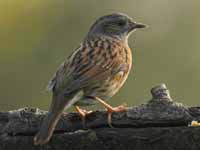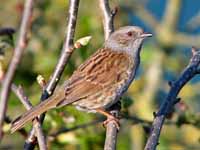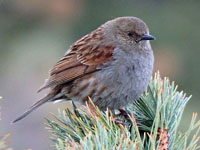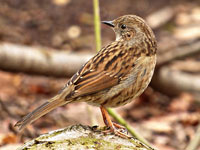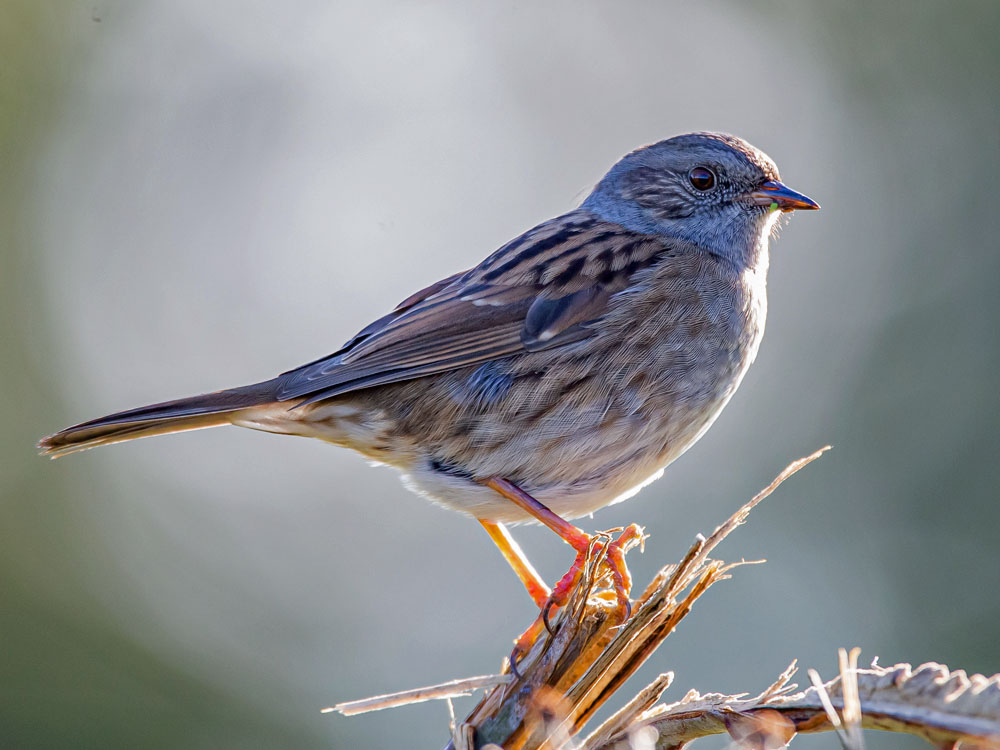The accentors are all in a single genus Prunella. Accentor from the Latin refers to people that sing together. In the case of these birds, they are loud and music. Accentors and dull brown of plumage; brown is usually their predominant color . They can be thought of as LBJs - little brown jobbies! In fact, one name for a common European accentor is the dunnock which comes from the old English for small brown bird! In spite of their appearance, accentors are probably more closely related to thrushes than to sparrows.
Accentors have a strong resemblance to sparrows, but they are very different in their behavior. The first choice of food of accentors is insects while the sparrows prefer seeds. These preferences are reflected in their bill shapes: accentors have thin bills for grasping their insects while sparrows have hefty bills for cracking seeds. During the winter when insects are scarce, an accentor will switch to seeds and some species will also eat berries. They may also swallow grit and sand to help their stomach break up these seeds. Accentors feed almost exclusively on the ground, often among thick vetation which can make them difficult to observe.
Most of the Prunellidae member are mountain oriented; in fact, many remain above the treeline during breeding season. In winter they tend to move lower in elevations or further south. Dunnocks are an exception to the rule - some are year round residents of lowlands, but some will adventure high up mountains in the summer. The same is true for the Japanese accentor.
Accentors spend the majority of their time in the undergrowth and even when flushed, stay low to the ground until reaching cover. Accentors may have two to three broods a year. Courtship consists of a great deal of song from the males, which may include short lark-like song flights to attract a mate. In most species of accentor, the male and female share in the nest making. They build neat cup-shaped nests and lay about 4 unspotted green or blue eggs. Some accentors are monogamous, but many have more than one mate. This is true for the females as well as the males, In order of the male to insure the spread of his gene pool, the male will usually bring food not only to his primary mate, but other females that he has frequented.
Genus Prunella Found: mainly Asia, also Europe
Accentor,_Alpine Prunella collaris
Description: The alpine accentor has streaked brown upperparts. It has a grey head with some fine black streaks and a fine point bill (the better to grab insect). The neck is grey as is the upper-breast. The rest of the underparts have red-brown spotting. Male and females are prone to have more than one mate during the breeding season. In fact, the female's nest may have eggs fertilized by different males. A male will bring food to those nests he has had an interet in. The alpine accentor is about 16 cm long.
Range: Europe, Asia.
Habitat: Above the tree-line during breeding season. Moves to lower altitudes in the winter.
Diet: Mainly insects and spiders when available. Also grass and pine seeds, berries.
Conservation status: Least Concern.
Range: Europe, Asia.
Habitat: Above the tree-line during breeding season. Moves to lower altitudes in the winter.
Diet: Mainly insects and spiders when available. Also grass and pine seeds, berries.
Conservation status: Least Concern.
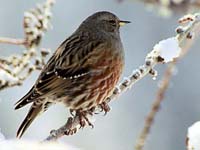
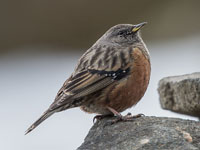
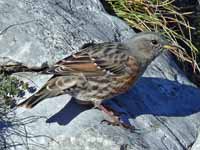
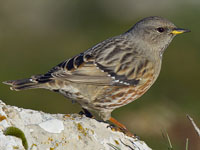
Accentor,_Altai Prunella himalayana
Description: The Altai accentor, also known as the Himalayan accentor, has greyish-brown upperparts with black streaks. The head is grey. It has rufous flanks fading to white towards the median of the underparts. The Altai accentor is about 15 cm long.
Range: Central Asian Asian to Afghanistan, Tibet and northwestern India.
Habitat: Above tree-line during the summer; lower altitudes in the winter, but still usually above 1000 meters.
Diet: Insects, spiders, snails. During the winter seeds, berries.
Conservation status: Least Concern.
Range: Central Asian Asian to Afghanistan, Tibet and northwestern India.
Habitat: Above tree-line during the summer; lower altitudes in the winter, but still usually above 1000 meters.
Diet: Insects, spiders, snails. During the winter seeds, berries.
Conservation status: Least Concern.
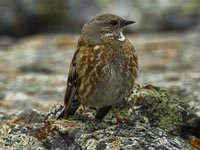
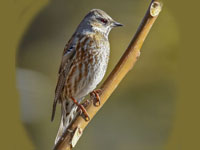

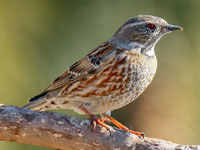
Accentor,_Black-throated Prunella atrogularis
Description: The black-throated accentor has a black-streaked brown its back. It has a black throat, crown, nape and face patch;. There is a white supercilium. The breast is orange-buff; the flanks have the same coloring with brown stripes. The belly is buff with orange stripes when the feathers are fresh and whitish when they are worn. It appears to be monogamous during the breading season; prefers to nest in spruce thicket with the nest made by a female and also incubated by her. The male participates in feeding chicks. The black-throated accentor is 13 to 15 cm long.
Range: Western Asia.
Habitat: Montane in breeding season and favors dense undergrowth. During winter they may seek lower elevation or migrate to warmer climates. The winter habitat is also variable from semi-desert to moist cultivated areas.
Diet: Mainly insects and spiders when available. Also seeds.
Conservation status: Least Concern.
Range: Western Asia.
Habitat: Montane in breeding season and favors dense undergrowth. During winter they may seek lower elevation or migrate to warmer climates. The winter habitat is also variable from semi-desert to moist cultivated areas.
Diet: Mainly insects and spiders when available. Also seeds.
Conservation status: Least Concern.
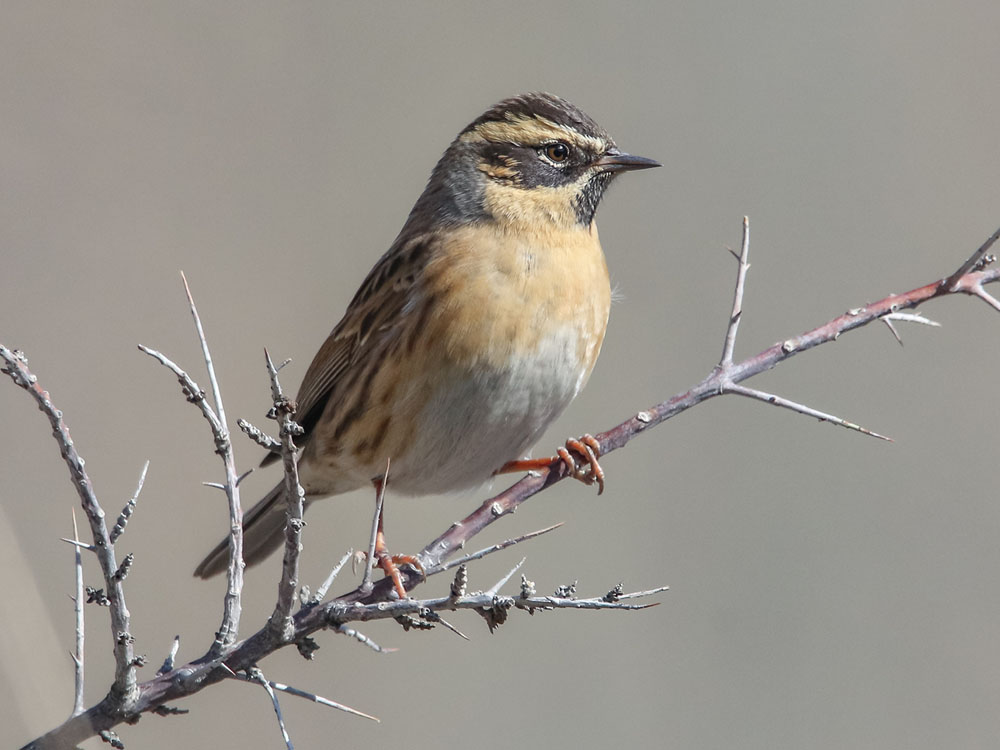

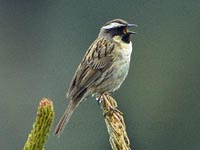
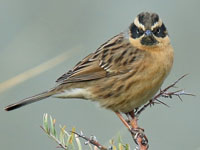
Accentor,_Brown Prunella fulvescens
Description: The brown accentor has brown upperparts with some grey on the nape. It has a white supercilium, dark brown to blackish lores that extend to an eye-line and widens to an ear patch. Its crown is also dark brown to black. The underparts are buffy.The brown accentor is about 15 cm long. The similar black-throated accentor has a black throat.
Range: Widespread in Asia.
Habitat: Mountainous areas. Some above tree-line year round, while others descend below tree-line in the winter. They do not appear to migrate.
Diet: Mainly insects and spiders when available. Also seeds, berries.
Conservation status: Least Concern.
Range: Widespread in Asia.
Habitat: Mountainous areas. Some above tree-line year round, while others descend below tree-line in the winter. They do not appear to migrate.
Diet: Mainly insects and spiders when available. Also seeds, berries.
Conservation status: Least Concern.


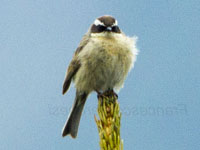
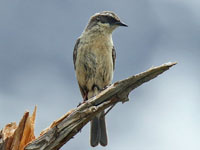
Accentor,_Japanese Prunella rubida
Description: The Japanese accentor has chestnut brown upperparts with dark streaks. It has a brown crown, grey nape, grey breast, and grey upper-belly. The lower-belly and flanks are grey with rufous streaks. female may have more than one partner and more than one male may feed the chicks.
Range: Japan, Sakhalin (Russian Island).
Habitat: Mountains during breeding season; lower and / or more south in the winter.
Diet: Insects and other invertebrates; seeds in the winter.
Conservation status: Least Concern.
Range: Japan, Sakhalin (Russian Island).
Habitat: Mountains during breeding season; lower and / or more south in the winter.
Diet: Insects and other invertebrates; seeds in the winter.
Conservation status: Least Concern.
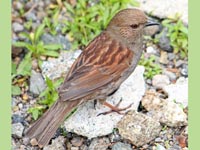
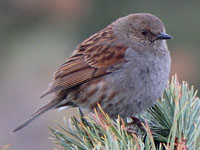
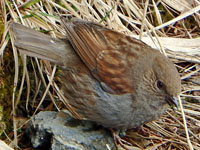
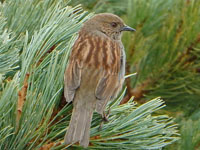
Accentor,_Maroon-backed Prunella immaculata
Description: The maroon-backed accentor has unstreaked mainly maroon upperparts. The upper-mantle is grey while the head is a darker grey with black lores. It is the only accentor with yellow eyes. The maroon-backed accentor is about 15 cm long.
Range: Bhutan, China, India, Myanmar, Nepal,
Habitat: During breeding season between located 3000 to 5000 meters and during the winter between 1500 to 3500 meters.
Diet: Insects and other invertebrates; seeds and berries in the winter. Forages under dense vegetation; they are difficult to observe.
Conservation status: Least Concern.
Range: Bhutan, China, India, Myanmar, Nepal,
Habitat: During breeding season between located 3000 to 5000 meters and during the winter between 1500 to 3500 meters.
Diet: Insects and other invertebrates; seeds and berries in the winter. Forages under dense vegetation; they are difficult to observe.
Conservation status: Least Concern.
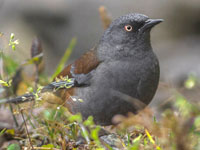


Accentor,_Mongolian Prunella koslowi
Description: The Mongolian accentor, also known as the Kozlov's accentor, has light brown upperparts with streaking on the back. It has a plain brown head and buffy underparts. The Mongolian accentor is about 15 cm long.
Range: Northern China, Mongolia.
Habitat: Mountains and plateaus.
Diet: Probably insects, seeds, berries.
Conservation status: Least Concern.
Range: Northern China, Mongolia.
Habitat: Mountains and plateaus.
Diet: Probably insects, seeds, berries.
Conservation status: Least Concern.
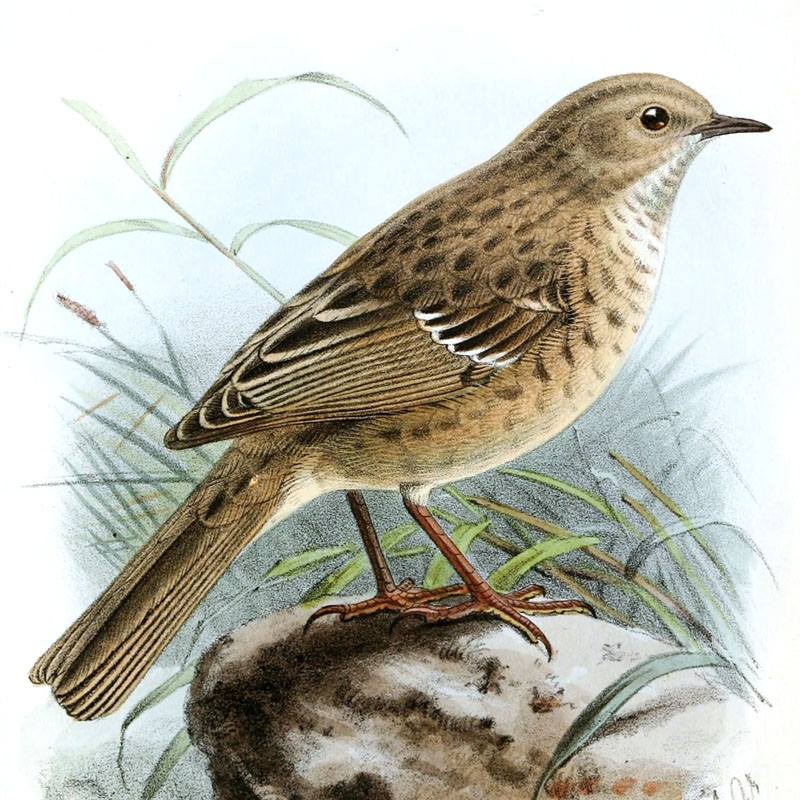
Accentor,_Radde's Prunella ocularis
Description: The Radde's accentor has dark streaked brown upperparts. It has a brownish-black crown and a face with a bold white supercilium. The underparts are buff with some orange. The Radde's accentor is about 15 cm long.
Range: Yemen, southwest Asia.
Habitat: Typically above treeline in summer and lower elevations during the winter.
Diet: Insects, spiders, seeds, berries.
Conservation status: Least Concern.
Image by:
1) Werner_Witte - Turkey 2) Vince_Smith - Turkey 3) Sergei_Drovetski - ArmeniaRange: Yemen, southwest Asia.
Habitat: Typically above treeline in summer and lower elevations during the winter.
Diet: Insects, spiders, seeds, berries.
Conservation status: Least Concern.
1, 2) Female 3) Male
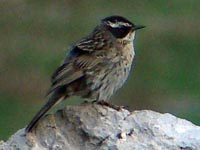
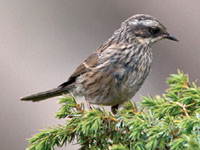
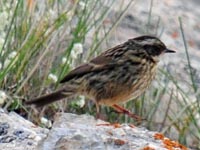
Accentor,_Robin Prunella rubeculoides
Description: The robin accentor upperparts are mainly brown streaked with black.. It has a grey head, grey neck, reddish-orange upper-breast, and a pale buff belly. The robin accentor is 17 cm long. Its cup-shaped nest is placed on the ground in a bush or even tuft of grass.
Range: Afghanistan, Pakistan, India, Nepal, Bhutan and China.
Habitat: Mountainous regions. 3000 to 5000 meters; above tree-line except for winter.
Diet: Insects, other invertebrates, seeds.
Conservation status: Least Concern.
Range: Afghanistan, Pakistan, India, Nepal, Bhutan and China.
Habitat: Mountainous regions. 3000 to 5000 meters; above tree-line except for winter.
Diet: Insects, other invertebrates, seeds.
Conservation status: Least Concern.
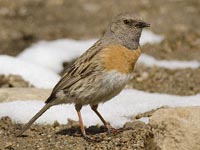
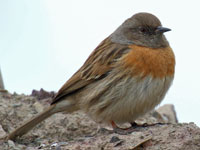
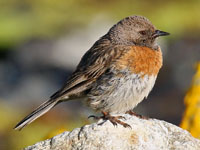

Accentor,_Rufous-breasted Prunella strophiata
Description: The rufous-breasted accentor has brown upperparts with black streaks. The crown is brown with a black stripe along either edge. It has a rufous and white supercilium. The upper-breast is reddish-orange and it has a pale buff belly. The rufous-breasted accentor is 15 cm long.
Range: The Himalayas of Afghanistan, Bhutan, Tibet, China, India, Myanmar, Nepal, Pakistan.
Habitat: Usually just below the tree-line, except during the winter it decends considerably lower.
Diet: Insects, other invertebrates, seeds, berries.
Conservation status: Least Concern.
Range: The Himalayas of Afghanistan, Bhutan, Tibet, China, India, Myanmar, Nepal, Pakistan.
Habitat: Usually just below the tree-line, except during the winter it decends considerably lower.
Diet: Insects, other invertebrates, seeds, berries.
Conservation status: Least Concern.
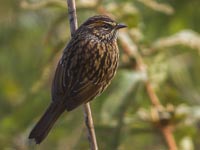
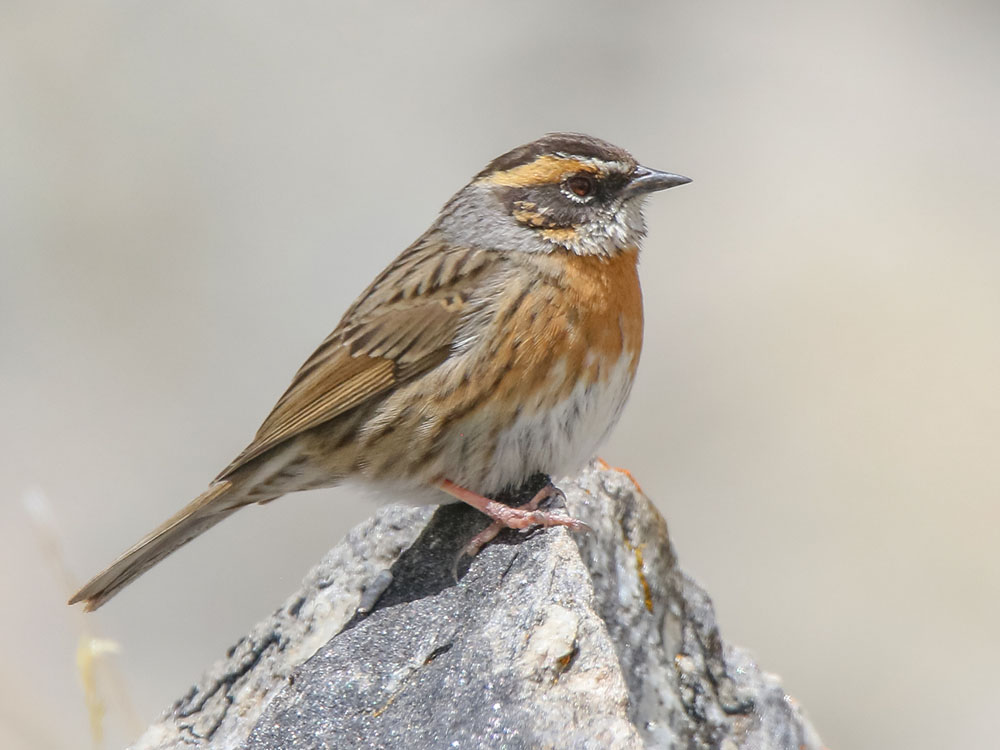
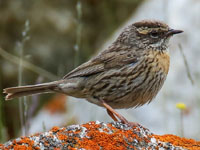

Accentor,_Siberian Prunella montanella
Description: The Siberian accentor has streaked reddish-brown upperparts. It has a dark crown and cheeks, a buff supercilium. and a partial white eye-ring arc below the eye. The throat is also buff and the underparts are yellowish rusty-buff. The Siberian accentor is up to 15 cm long. It has a cup-shaped nest in a dense bush or tree.
Range: Northern Russia from the Ural Mountains eastwards across Siberia.
Habitat: Montane forests below the tree-line. Prefers to be near streams.
Diet: Insects, seeds, berries.
Conservation status: Least Concern.
Range: Northern Russia from the Ural Mountains eastwards across Siberia.
Habitat: Montane forests below the tree-line. Prefers to be near streams.
Diet: Insects, seeds, berries.
Conservation status: Least Concern.
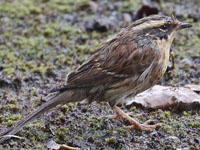
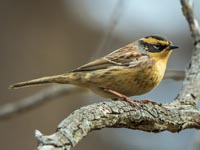

Accentor,_Yemen Prunella fagani
Description: The Yemen accentor, also known as the Arabian accentor, has brown upperparts with black streaks. It has a bold white supercilium and below there is a black face patch. The underparts are buff, with brown stripes on the flanks. The Yemen accentor is about 15 cm long. It is sometimes considered to be conspecific with the Radde's accentor. The Yemen accentor has more streaking on its head.
Range: Yemen, south Arabia
Habitat: Breeds in mountains of Yemen and winters a little further south.
Diet: Unknown.
Conservation status: Least Concern.
Range: Yemen, south Arabia
Habitat: Breeds in mountains of Yemen and winters a little further south.
Diet: Unknown.
Conservation status: Least Concern.

Dunnock Prunella modularis
Description: The dunnock, also known as the hedge accentor, has brown upperparts with black streaks. It has a grey head, throat, and breast. The flanks have brown streaks and the lower belly is white. The dunnock is about 14 cm long. They are flexible in approach to breeding. Depending of the availablitiy of partners, some will be monogamous, females may have more than one partner, and similarly for the male. Males are prone to help feed chicks of more than one of his mates. The dunnock does not favor high mountainous area - it is usually a lowland dunnock. Thus it should not be confused with other dunnocks, and the thin bill differentiates it from sparrow.
Range: Most of Europe, western Asia.
Habitat: Woodlands, shrubs, gardens.
Diet: Insects and other arthropods. Also seeds when insects are scarce.
Conservation status: Least Concern.
Range: Most of Europe, western Asia.
Habitat: Woodlands, shrubs, gardens.
Diet: Insects and other arthropods. Also seeds when insects are scarce.
Conservation status: Least Concern.
